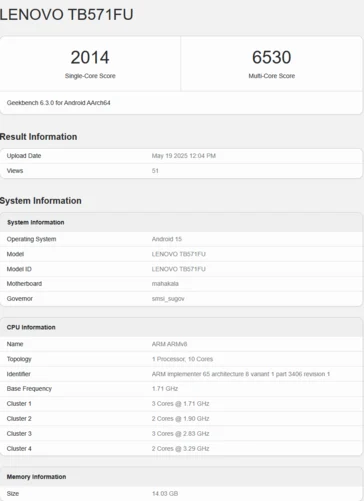Key Takeaways
1. Lenovo has introduced the Yoga Pad Pro 14.5 with notable features like a 1,600 nits OLED display and 16 GB of RAM.
2. The new device is expected to use Lenovo’s first in-house system-on-chip (SoC), named the Lenovo SS1101.
3. The SS1101 SoC has a 10-core CPU with varying clock speeds and includes a combination of Cortex cores.
4. Geekbench scores for the SS1101 are 2,014 in single-core and 6,530 in multi-core, making it competitive but not groundbreaking.
5. The SS1101 may be manufactured using TSMC’s N5 process node, which could affect its performance compared to competitors.
Lenovo has quietly revealed the Yoga Pad Pro 14.5, featuring standout specifications such as an OLED display boasting a peak brightness of 1,600 nits and 16 GB of RAM. However, details about its system-on-chip (SoC) were not disclosed. While it is reasonable to think it would be a standard component from Qualcomm or MediaTek, previous leaks suggested this might be Lenovo’s very first in-house SoC. Now, a recent listing on Geekbench seems to verify this assumption.
Details of the New SoC
This new SoC is named the Lenovo SS1101, and it boasts a 10-core CPU organized into clusters: 2 cores at 3.29 GHz, 3 cores at 2.83 GHz, 2 cores at 1.90 GHz, and 3 cores at 1.71 GHz. The first cluster features two Cortex-X3 cores, but no further details have been provided about the other clusters. There’s a solid possibility it could incorporate a combination of Cortex-A725, Cortex-A720, and Cortex-A520 cores similar to the Xiaomi Xring O1. The CPU is paired with an Arm Immortalis-G720 GPU.
Performance Comparisons
The Lenovo SS1101 achieved scores of 2,014 in single-core and 6,530 in multi-core tests on Geekbench 6.4. Although it may not be as remarkable as Xiaomi’s first offering, it still represents a fairly capable chip, comparable to last year’s Exynos 2400. Moreover, reports suggest that the SS1101 may be manufactured using TSMC’s N5 node, which could put it at a considerable disadvantage against the Xring O1.
Source:
Link





